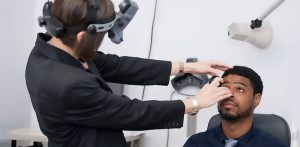Up to 90% of patients who have sustained a brain injury suffer from eye movement problems.
The state of one’s eyes is a good indicator of how well one’s brain is working. When there’s a problem with the brain, visual or ocular symptoms are common.
What is a brain injury?
A brain injury is defined as any condition that causes harm or damage to the brain.
Stroke, tumor, encephalitis, brain hemorrhage, and traumatic brain injuries from concussion, contusion, penetrating injury, and anoxic brain damage, are all examples of a brain injury.
Vision is the sense that utilizes the majority of the brain’s processing, compared to the other senses, visual symptoms are extremely common following a brain injury.
If you’ve experienced any vision changes after a brain injury, contact an eye doctor near you.
SEE RELATED: Vision and Brain Injuries
How can a brain injury impact eye movements?
Many different types of visual activity and eye movements have their own or shared pathways in the brain.
Depending on which pathway has been damaged, different eye problems can occur.
Tracking problems
Our eyes rely on a visual skill known as smooth pursuit to track a moving object.
Watching TV, driving, scrolling through text on a phone or doing anything else that requires a steady look at a moving target will be difficult for people who have trouble with smooth pursuits.
When a person’s eyes have strong smooth pursuits, they can constantly focus incoming light into the fovea, a portion of the retina. This necessitates a great deal of fine muscular control, as well as feedback from numerous brain regions.
Smooth pursuits may fail if the connections between these regions are broken as a result of a brain injury, and vision may be briefly blurred.
A person’s eyes may compensate for a failed smooth pursuit by performing a corrective saccade, which is a quick eye movement that attempts to reposition the light’s focus onto the fovea.
When in a visually intense setting, a person with eye movement issues will suffer a large amount of corrective saccades, making them feel “foggy” or exhausted.
Nystagmus
Another possible visual consequence of a brain injury is nystagmus. Rapid, uncontrollable eye movements (up or down, side to side, or circular motions) are the primary symptom of this condition .
These eye movements may occur all of the time or only when looking in a specific direction.
Nystagmus causes dizziness because it causes a person’s brain to interpret objects in their surroundings as moving, rather than still.
Strabismus
Strabismus, often known as a squint or eye turn, is a condition where one eye is turned inward, outward, up, or down.
Strabismus can affect a patient on a regular or irregular basis, resulting in symptoms such as blurred vision, double vision, and poor depth perception.
How can neuro-optometry help?
Neuro-optometry aims to strengthen the communication between the eyes and the brain thereby allowing the visual system to function.
Neuro-optometrists use a personalized program of eye exercises, therapeutic lenses, and prisms to rehabilitate the visual system.
Because each person’s brain reacts to brain injury differently, treatment is tailored to the specific needs of each patient.
Many patients with persisting visual symptoms after brain injuries have benefited from neuro-optometric rehabilitation therapy.
Even if your vision is clear, if you suffer symptoms such as dizziness, nausea, sensitivity to light, or anxiety, you may have a vision problem.
LEARN MORE: Guide to Neuro-Optometry
Get your vision checked by scheduling a functional visual evaluation with an eye doctor near you.










